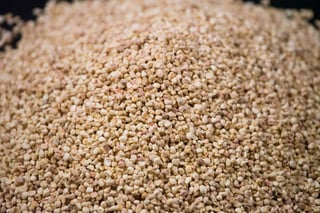Corn Cob Abrasive Material for Media Blasting

Corn Cob Abrasive Material for Media Blasting
Arguably the most important piece of the abrasive media blasting puzzle outside of the selection of equipment itself is the type of media used for each application. With several types available on the market for surface preparation, the decision often boils down to efficiency, cost and availability. To the surprise of many, one popular media type is crushed corn cob. That's right — instead of tossing the remains of your corn on the cob this summer, you could actually grind them down them for use in a Dustless Blasting machine!
What is Corn Cob Media?
Corn cob media, derived from the hard woody ring of the ear of corn, is a natural, biodegradable, and soft media made from finely ground corn cores. Its unique properties make it suitable for a variety of industrial and environmental applications where gentler blasting is required (and it also makes for an excellent garden mulch!). This media option is produced by grinding the cob into different grades, typically ranging from fine to coarse.
What Are the Properties of Corn Cob Media?
Lightweight
Corn media is significantly lighter than other blasting media like sand or glass beads. This allows for softer abrasion that will not damage surfaces.
Non-Abrasive
Thanks to its gentle abrasive qualities, this media is much less harsh than blowing grit or aluminum oxide.
Biodegradable and Eco-friendly
Corn cob is typically categorized as an organic material, which means it is completely biodegradable, non-toxic, and environmentally friendly. It leaves no harmful residues after use.
Absorptive
Crushed cob is highly absorbent, which means it can remove oils, dirt, grease, and other contaminants while blasting. It has also been used to kill mold.
Reusable
This is a type of abrasive that can be reused multiple times before breaking down, depending on the application and surface material being cleaned.
Pros of Corn Cob Blasting
Corn cob media is ideal for cleaning delicate surfaces, including wood, plastic, and soft metals because it won’t damage the base material like special wood cleaners might. Do keep in mind though, most log surfaces will require a special de-burring tool or sander after blasting to remove the "fuzz" that can sometimes occur when treating certain types of wood.
The organic, biodegradable nature of corn cob media means there are no toxic by-products or harmful chemicals like you might see in chemical stripping. This reduces risks to both the workers doing the blasting and the environment. Compared to other blast media such as sand, corn cob generates far less dust, improving visibility and air quality in the work area.
Corn cob media can often be reused multiple times, making it an economical option in terms of long-term cost savings.
Cons of Corn Cob Blasting
While the gentle nature of corn cob abrasive media is advantageous for some applications, it may not be suitable for heavy-duty jobs that require deep cleaning or paint removal from hard surfaces like steel. For example, it may not effectively remove rust, scale, or heavy corrosion, limiting its versatility. It has also been noted that this particular type of media can be expensive and might even attract rodents to the job site.
As it is softer and lighter than other abrasives, it may take longer to clean surfaces compared to more aggressive media like crushed glass or pyroxene. When used repeatedly on harder materials, corn cob media can break down at a faster rate if used for more than a light wash or stain remover. It also can mold when wet, so keeping this media dry is important. Lastly, as it floats in water, it is only able to be used for dry blasting applications.
Thanks to the versatility of the Dustless Blasting technology, wet and dry blasting are both options for the blast pot, so corn cob blasting is highly popular amongst Dustless Blasting business owners. For more on the differences between wet blasting and dry blasting, click here.
Applications of Corn Cob Blasting
This media excels in jobs that require gentle cleaning, polishing, or finishing. Some of the more popular uses include:
-
Wood Cleaning and Log Home Restoration
-
Surface Polishing
-
Cleaning Turbines and Engine Components
-
Removing Debris from Plastic and Rubber Molds
-
De-burring and De-flashing
-
Industrial Cleaning

What Dustless Blasting Owners Are Saying About Corn Cob Media
"I use corn cob frequently. It is great for log homes and wood siding; pretty much anything wood that you don’t want to have a heavy profile. Be sure to match your grain size to the profile you want. The great thing about it is the ability to recycle. Tarp the area around your project and capture the over spray. [It will save you] a lot of money." — R.C., Dustless Blasting Business Owner
"Log home work is 50% or more of my business. Corn is great for natural log or 30-year old stain. It is safe on glass (don't blast it directly) and cuts down on clean up — gone with the wind — and saves on masking. — J.S., Dustless Blasting Business Owner
"Quick little job on some wood entry doors. [We used] fine corn cob blasting at 40psi and a 36” stand-off and [be sure to] keep moving!" — R.R., Dustless Blasting Business Owner
Conclusion
Corn cob blast media offers a unique blend of gentleness and efficiency, making it ideal for log home restoration and light surface cleaning.
Its eco-friendly nature, reusability, and ability to clean soft surfaces make it a valuable tool for industries like woodworking, plastics, and industrial maintenance. However, it may not be the best choice for heavy-duty jobs or those that require aggressive blasting power, nor is if efficient in a wet blasting application.
Check out our guide to sand blast media for more information on other abrasive materials.


